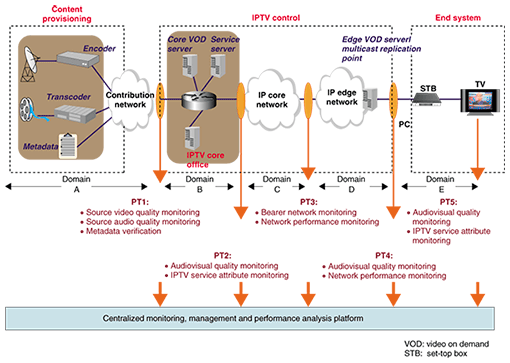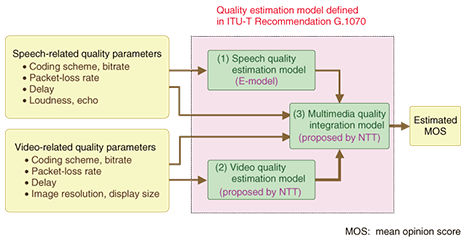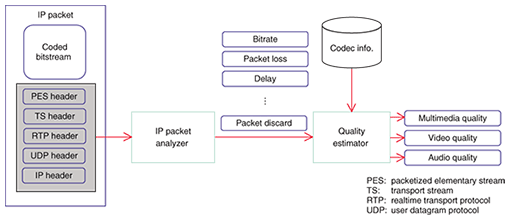 |
|||||||||||||||||||
|
|
|||||||||||||||||||
|
Global Standardization Activities Vol. 6, No. 9, pp. 37–41, Sept. 2008. https://doi.org/10.53829/ntr200809gls Recent Activities of QoS/QoE Standardization in ITU-T SG12AbstractThis article introduces recent standardization activities related to the evaluation and management of the quality of service (QoS) and quality of experience (QoE) of speech and video and to network performance parameters and objectives, focusing on the activities of ITU-T SG12 (International Telecommunication Union, Telecommunication Standardization Sector, Study Group 12), which is responsible for standardization work on the end-to-end transmission performance of terminals and networks.
1. ITU-T SG12ITU-T SG12 (International Telecommunication Union, Telecommunication Standardization Sector, Study Group 12) is a lead study group on network performance and quality of service (QoS) and quality of experience (QoE). In January 2005, SG12 was restructured by incorporating some questions on network performance, which had been studied in SG13. ITU-T SG12 is the leader in the world-wide standardization of speech and video quality evaluation, taking into account achievements in regional standardization bodies such as ETSI (European Telecommunications Standards Institute) and ATIS (Alliance for Telecommunications Industry Solutions). On the other hand, standardization work on network performance parameters and objectives is carried out in various standardization organizations. However, all the organizations have confirmed that their work matches that of SG12. 2. IPTV-GSIFG-IPTV (IPTV Focus Group), which was launched in April 2006 to harmonize regional standards and technical specifications for Internet protocol television (IPTV), was terminated at the Malta meeting in December 2007. The output documents from FG-IPTV are now being considered for standardization in IPTV-GSI (GSI: Global Standards Initiative), which consists of multiple Study Groups in ITU-T. The parent Study Group is SG13. The following documents related to QoS/QoE issues had been discussed in Working Group 2 in FG-IPTV:
Items (a) and (d) were transferred to Question 13 in SG12 (Q.13/12) and (b) and (c) were transferred to SG13 and SG16, respectively. Item (a) describes the QoE requirements for IPTV services and is now called G.IPTV-QoE as a draft Recommendation. This includes the quality of video, audio, text, and graphics, as well as the quality of control functions such as channel zapping delay, checking the correctness of metadata, and the functionality of the electronic program guide (EPG) and browser, for example. Item (d) defines performance-monitoring points, performance parameters to be monitored at each monitoring point, and methods of estimating QoE from monitored performance parameters. SG12 will first standardize the performance monitoring points as a new Recommendation G.IPTV-PMP. After that, it will provide a family of Recommendations defining the remaining issues in the current document. Definitions of performance-monitoring points in the current draft are shown in Fig. 1.
3. QoE evaluation methods for quality designITU-T standardized a quality-planning tool for telephony services as Recommendation G.107, which is also called the E-model. The output of the E-model is transmission rating scale R. The Japanese government adopted the R-value as a quality index for IP telephony services. Therefore, service providers are required to evaluate the R-value of their services in order to obtain telephone numbers from the government for their customers. SG12 extended the scope of G.107 so that it can cover so-called wideband (100–7000-Hz) speech communication services and provided G.107 Amendment 1. SG12 also standardized G.113 Amendment 1, which provides the quality data of wideband speech codecs. To obtain this data, the University of Tsukuba and NTT collaborated with Deutsch Telekom and France Telecom. In addition, SG12 has also been studying similar models for multimedia services. In May 2007, Recommendation G.1070, which provides a quality-planning model for video-telephony applications, was standardized. This standard adopts a model that was studied and proposed by NTT. A block diagram of the G.1070 model is shown in Fig. 2. Moreover, SG12 has started investigating such a model for IPTV services. This project is provisionally called G.OMVAS (opinion model for video and audio streaming applications), which is expected to be standardized in 2009.
4. QoE evaluation methods for in-service quality monitoringAnother important application of QoE evaluation methods is in-service non-intrusive quality monitoring. In such a scenario, using media signals such as audio and video is almost impossible for predicting perceived quality because of the limitation of the processing load. This led us to develop packet-layer objective quality models, which estimate QoE solely based on packet-header information. For IP telephony services, ITU-T standardized Recommendation P.564 in 2006. This Recommendation determines the performance criteria for objective quality models. That is, models that estimate the QoE more accurately than the criteria are all regarded as P.564-compliant models. SG12 is now working on models for IPTV. Q.14/12 is responsible for these projects, which are provisionally called P.NAMS (non-intrusive parametric model for assessment of performance of multimedia streaming) and P.NBAMS (non-intrusive bit-stream model for assessment of performance of multimedia streaming). P.NAMS utilizes only packet-header information (e.g., from IP through MPEG2-TS), while P.NBAMS is allowed to use the payload information (i.e., coded bitstream). The concept of P.NAMS is illustrated in Fig. 3. If the payload information is encrypted, which is often the case in IPTV, P.NBAMS cannot be applied. In addition, P.NAMS is also useful when the processing load is very limited, e.g., monitoring inside the set-top box.
These projects in SG12 are being conducted in close collaboration with VQEG (Video Quality Experts Group). SG12 is responsible for determining the Terms of Reference, while VQEG should carry out the technical evaluation and selection of models. 5. Network performanceA lot of network QoS-related standardization work was achieved during the 2005–2008 study period. The work covered many fields, such as voice over Internet protocol (VoIP), the Next Generation Network (NGN), and IPTV. Network QoS mainly has two different performance aspects: session connecting/disconnecting performance and packet transfer performance. This article introduces Recommendations mainly related to packet transfer performance. 5.1 IP packet transfer and availability performance parameter (Y.1540)Y.1540 is the recommendation defining the basic common performance parameters for evaluating network performance. The specifications of these common parameters are the basis for quantitatively evaluating, measuring, and comparing network QoS performance. Y.1540 was revised in 2007. The main revised points are as follows.
5.2 Network performance objectives for IP-based services (Y.1541)Y.1541 is the recommendation specifying the objectives of end-to-end network performance or performance between user network interfaces (UNIs) based on Y.1540 parameters. Y.1541 was revised in 2005. New classes 6 and 7 were introduced, which have 2-digit lower loss and error rate objectives than the original classes 0–4. These new classes, including the objectives, are specified as “provisional classes” and are currently under discussion regarding application requirements. 5.3 Framework for achieving end-to-end IP performance objectives (Y.1542)Y.1542 describes some ideas regarding how the end-to-end performance objectives specified in Y.1541 can be achieved in multiple-carrier environments. This recommendation was originally called G.fepo and received consent in 2006. Notably, Y.1542 is a framework recommendation—i.e., it does not include anything to mandate. It simply discusses approaches for achieving the end-to-end performance objectives. It mainly describes two different approaches: (1) Impairment Allocation, which assigns a subset of end-to-end performance objectives to each provider on the path, thus achieving the total end-to-end performance objectives, and (2) Impairment Accumulation, which accumulates the sum of the performance budget commitment from each provider on the path and evaluates whether the end-to-end QoS requirements are fulfilled. 5.4 Measurements in IP networks for inter-domain performance assessment (Y.1543)Y.1543 specifies the measurement methodology for a network with a multi-provider environment. It was originally proposed in FG-NGN as TR-pmm (performance measurement and management), a document including both performance measurement and management. After FG-NGN, the document and the areas covered in it were divided and transferred to SG12 and SG13; SG12 took over the performance measurement section (Y.pm; performance measurement), and SG13 handled the management section (Y.mpm; management of performance measurement). In this Y.1543, a performance measurement “what and how” is described considering Y.mpm's management system, for example, the measurement requirements, specifications of which Y.1540 parameters are to be measured, measurement granularity, clock synchronization scheme for measurement at remote sites, and the making of summary information from separate measurements at each network segment along the path. 5.5 Multicast IP performance parameters (Y.IPmulti)The previous recommendations all focused on the quality of one-to-one communication (unicast communication). Today, with IPTV standardization, multicast communication is becoming more important than ever. Y.IPmulti, a draft recommendation that standardizes the quality parameters of IP multicast communication, is being developed by SG12, and consent will be sought in 2008. The draft defines multicast-specific ideas and parameters such as population of interest, meaning the one-way delay and one-way delay variation over the entire multicast group. 6. Future activitiesA quality evaluation method that can evaluate a user's perception of services appropriately is needed so that we provide users with new services with appropriate quality. So we need to monitor standardization activities in SG12. On the other hand, in the work on network performance, interconnections between network providers will be important issue. Thorough consideration should be given to the study items: “How can we measure network performance?” and “How can we achieve network performance objectives end-to-end?” in the interconnection network environment. |
|||||||||||||||||||













